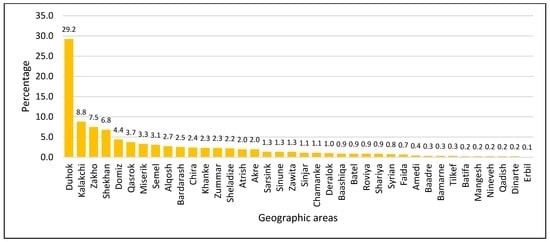- Article
Epidemiological and Clinical Profile of Hemoglobinopathies and Thalassemia in Duhok, Kurdistan Region of Iraq: A Retrospective Study
- Burhan Abdullah Zaman,
- Zuhair Rushdi Mustafa and
- Delshad Abdulah Mohamed
- + 2 authors
Background/Objectives: Thalassemia is among the most common hereditary disorders globally, characterized by impaired hemoglobin synthesis and ineffective erythropoiesis. This study analyzed data on hemoglobinopathies, with a particular focus on thalassemia, to support the development of a comprehensive national database and to improve understanding of the disease burden in the Kurdistan Region of Iraq. Methods: In this retrospective cross-sectional study, a total of 910 patients admitted to the region’s sole blood disorder center since its establishment were included. Results: The study analyzed 46.7% male and 53.3% female thalassemia patients in Duhok, with 58.46% reporting parental consanguinity. Hepatitis C virus (HCV) prevalence was 11.87%, while 8.90% underwent bone marrow transplantation (BMT) and 30.11% had splenectomies. Blood group distribution was O+ (36.26%), A+ (30.99%), and B+ (18.46%). Common medications included Deferasirox (34.62%), Hydroxyurea (26.70%), and Deferoxamine (5.82%), with 8.24% and 4.40% discontinuing Deferasirox and Hydroxyurea, respectively. Geographically, 29% of the patients originated from Duhok City, which exhibited a consanguinity rate of 18.65% (p = 0.020). The most prevalent conditions were β-thalassemia major (32.53%) and sickle cell anemia (24.73%). HCV-positive patients were predominantly diagnosed with β-thalassemia major (43.40%) and sickle cell anemia (33.96%). BMT recipients were mostly β-thalassemia major patients (80.25%), while splenectomy was common in β-thalassemia major (43.40%) and sickle cell β-thalassemia (22.64%). Vaccination rates included Pneumococcal (50.78%), Influenza (47.76%), and Hepatitis (39.08%, first dose). Six patients (0.66%) died, with 30.18% diagnosed before age 1 and 43.89% between 1 and 2 years. In conclusion, this study underscores the high prevalence of β-thalassemia major and sickle cell anemia in Duhok, with strong associations to parental consanguinity and low socioeconomic status. Gaps in early diagnosis and vaccination coverage remain significant challenges.
28 November 2025



